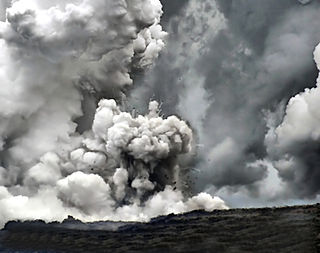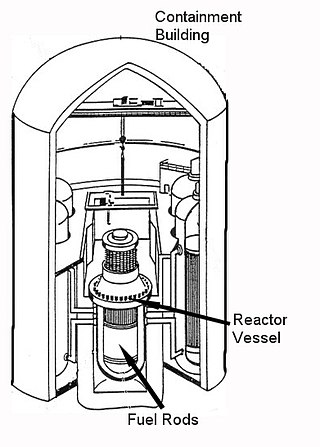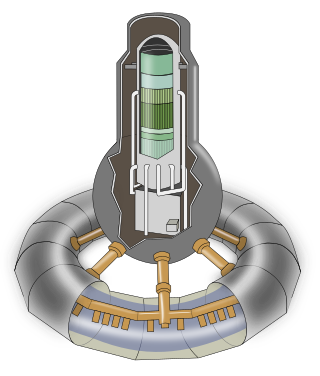This article needs additional citations for verification .(September 2013) |
This article needs additional citations for verification .(September 2013) |
R4 nuclear reactor was a nuclear reactor built at Marviken, Vikbolandet and the fourth nuclear reactor built in Sweden. It was heavy water moderated and intended for the dual role of 130MWe of power generation as well as plutonium production. It had a central role in the Swedish nuclear weapon programme. During the mid 1960s, the social democratic government officially abandoned the project of designing Swedish nuclear weapons and the Marviken plant became derelict. It was never loaded with fuel, and the project was cancelled in 1970.
The situation that the reactor was nearly completed, but never loaded with fuel, made it possible to use the plant for advanced international experiments during late 1970s and early 1980s, simulating various aspects of accident scenarios in nuclear power plants. [1] Four series of experiments were performed: [2]
Large amounts of data were collected and are archived at OECD/NEA, [2] and have been used for validation of computer simulation codes for nuclear power plants.
When the construction of the nuclear reactor was finally stopped 1970 a boiler house and an oil fired steam boiler was built. This made it possible to use the non-nuclear parts of the power station as well as the connecting power grid line. Since the turbine was optimized for the comparably low steam temperature and pressure from a nuclear reactor the efficiency of the oil fired plant became low (approximately 30 percent) compared to conventional fossil-fuel fired plants which may have efficiencies of 40 or even close to 50 percent. Hence the plant was only used as a peak load plant.
The oil fired boiler had a thermal power of approximately 700 MW at an oil consumption of 17 kg/s, and the corresponding electrical power was approximately 200 MW. The plant was in operation until March 2009, but has since been decommissioned.
The Nuclear reactor, the oil fired power station and surrounding 250 hectares of land and water was acquired by Synthesis Real Estate during 2018. Synthesis Analytics is building a computing center to leverage the vast access to energy (due to the extensive connections to the Swedish power grid) while Synthesis Real Estate will develop an Archipelago City heated by the surplus heat from the computing center.
The nuclear reactor at Marviken plays a big role in Swedish thriller/sci-fi writer Lars Wilderäng's 2020 novel Redovisningsavdelning Marviken (Swedish: "Accounting Department Marviken").

A pressurized water reactor (PWR) is a type of light-water nuclear reactor. PWRs constitute the large majority of the world's nuclear power plants. In a PWR, the primary coolant (water) is pumped under high pressure to the reactor core where it is heated by the energy released by the fission of atoms. The heated, high pressure water then flows to a steam generator, where it transfers its thermal energy to lower pressure water of a secondary system where steam is generated. The steam then drives turbines, which spin an electric generator. In contrast to a boiling water reactor (BWR), pressure in the primary coolant loop prevents the water from boiling within the reactor. All light-water reactors use ordinary water as both coolant and neutron moderator. Most use anywhere from two to four vertically mounted steam generators; VVER reactors use horizontal steam generators.

A boiling water reactor (BWR) is a type of light water nuclear reactor used for the generation of electrical power. It is a design different from a Soviet graphite-moderated RBMK. It is the second most common type of electricity-generating nuclear reactor after the pressurized water reactor (PWR), which is also a type of light water nuclear reactor.

A nuclear meltdown is a severe nuclear reactor accident that results in core damage from overheating. The term nuclear meltdown is not officially defined by the International Atomic Energy Agency or by the United States Nuclear Regulatory Commission. It has been defined to mean the accidental melting of the core of a nuclear reactor, however, and is in common usage a reference to the core's either complete or partial collapse.

The light-water reactor (LWR) is a type of thermal-neutron reactor that uses normal water, as opposed to heavy water, as both its coolant and neutron moderator; furthermore a solid form of fissile elements is used as fuel. Thermal-neutron reactors are the most common type of nuclear reactor, and light-water reactors are the most common type of thermal-neutron reactor.
Passive nuclear safety is a design approach for safety features, implemented in a nuclear reactor, that does not require any active intervention on the part of the operator or electrical/electronic feedback in order to bring the reactor to a safe shutdown state, in the event of a particular type of emergency. Such design features tend to rely on the engineering of components such that their predicted behaviour would slow down, rather than accelerate the deterioration of the reactor state; they typically take advantage of natural forces or phenomena such as gravity, buoyancy, pressure differences, conduction or natural heat convection to accomplish safety functions without requiring an active power source. Many older common reactor designs use passive safety systems to a limited extent, rather, relying on active safety systems such as diesel powered motors. Some newer reactor designs feature more passive systems; the motivation being that they are highly reliable and reduce the cost associated with the installation and maintenance of systems that would otherwise require multiple trains of equipment and redundant safety class power supplies in order to achieve the same level of reliability. However, weak driving forces that power many passive safety features can pose significant challenges to effectiveness of a passive system, particularly in the short term following an accident.

A steam explosion is an explosion caused by violent boiling or flashing of water or ice into steam, occurring when water or ice is either superheated, rapidly heated by fine hot debris produced within it, or heated by the interaction of molten metals. Pressure vessels, such as pressurized water (nuclear) reactors, that operate above atmospheric pressure can also provide the conditions for a steam explosion. The water changes from a solid or liquid to a gas with extreme speed, increasing dramatically in volume. A steam explosion sprays steam and boiling-hot water and the hot medium that heated it in all directions, creating a danger of scalding and burning.

Ringhals is a nuclear power plant in Sweden. It is situated on the Värö Peninsula in Varberg Municipality approximately 65 km south of Gothenburg. With a total power rating of 2,190 MWe, it is the second largest power plant in Sweden. It is owned 70% by Vattenfall and 30% by Uniper SE.

A containment building is a reinforced steel, concrete or lead structure enclosing a nuclear reactor. It is designed, in any emergency, to contain the escape of radioactive steam or gas to a maximum pressure in the range of 275 to 550 kPa. The containment is the fourth and final barrier to radioactive release, the first being the fuel ceramic itself, the second being the metal fuel cladding tubes, the third being the reactor vessel and coolant system.

A thermal power station is a type of power station in which heat energy is converted to electrical energy. In a steam-generating cycle heat is used to boil water in a large pressure vessel to produce high-pressure steam, which drives a steam turbine connected to an electrical generator. The low-pressure exhaust from the turbine enters a steam condenser where it is cooled to produce hot condensate which is recycled to the heating process to generate more high pressure steam. This is known as a Rankine cycle.

The supercritical water reactor (SCWR) is a concept Generation IV reactor, designed as a light water reactor (LWR) that operates at supercritical pressure. The term critical in this context refers to the critical point of water, and must not be confused with the concept of criticality of the nuclear reactor.

The Economic Simplified Boiling Water Reactor (ESBWR) is a passively safe generation III+ reactor design derived from its predecessor, the Simplified Boiling Water Reactor (SBWR) and from the Advanced Boiling Water Reactor (ABWR). All are designs by GE Hitachi Nuclear Energy (GEH), and are based on previous Boiling Water Reactor designs.
The electricity sector in Sweden has three operational nuclear power plants with 6 operational nuclear reactors, which produce about 29.8% of the country's electricity. The nation's largest power station, Forsmark Nuclear Power Plant, has three reactors producing 3.3 GW and 14% of Sweden's electricity.
This page describes how uranium dioxide nuclear fuel behaves during both normal nuclear reactor operation and under reactor accident conditions, such as overheating. Work in this area is often very expensive to conduct, and so has often been performed on a collaborative basis between groups of countries, usually under the aegis of the Organisation for Economic Co-operation and Development's Committee on the Safety of Nuclear Installations (CSNI).

Dodewaard nuclear power plant was a nuclear power plant with a 55 MWe boiling water reactor (BWR) of General Electric in the Dutch town of Dodewaard. The plant halted energy production in 1997. Its final decommissioning has been postponed for a period of 40 years and was placed into a safe enclosure configuration in 2005.

Carolinas–Virginia Tube Reactor (CVTR), also known as Parr Nuclear Station, was an experimental pressurized tube heavy water nuclear power reactor at Parr, South Carolina in Fairfield County. It was built and operated by the Carolinas Virginia Nuclear Power Associates. CVTR was a small test reactor, capable of generating 17 megawatts of electricity. It was officially commissioned in December 1963 and left service in January 1967.
The three primary objectives of nuclear reactor safety systems as defined by the U.S. Nuclear Regulatory Commission are to shut down the reactor, maintain it in a shutdown condition and prevent the release of radioactive material.
A nuclear reactor coolant is a coolant in a nuclear reactor used to remove heat from the nuclear reactor core and transfer it to electrical generators and the environment. Frequently, a chain of two coolant loops are used because the primary coolant loop takes on short-term radioactivity from the reactor.
Boiling water reactor safety systems are nuclear safety systems constructed within boiling water reactors in order to prevent or mitigate environmental and health hazards in the event of accident or natural disaster.
A Filtered Containment Venting System (FCVS) is an accident management system designed to minimize the release of fission products when releasing the pressure of the containment building in the case of a severe nuclear accident. As a Severe Accident Management Measure (SAMM), containment venting cannot prevent a meltdown but can help alleviate its consequences on the environment.

General Electric's BWR product line of boiling water reactors represents the designs of a relatively large (~18%) percentage of the commercial fission reactors around the world.